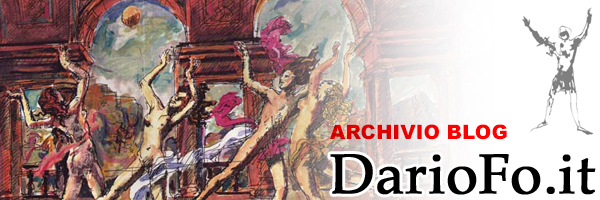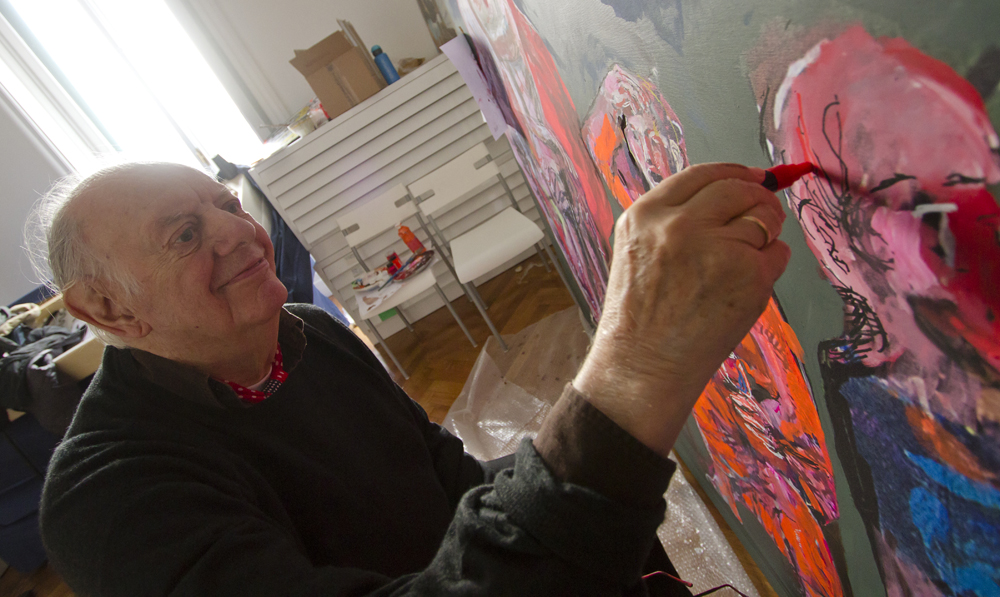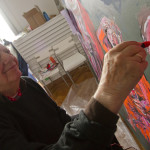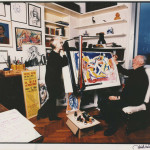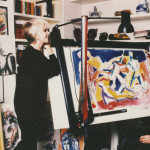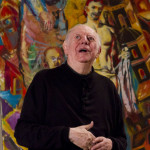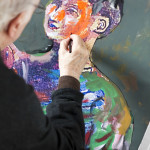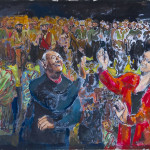By Giuliana de Antonellis – 27/03/2012
The “genius” and “jokes” by Dario Fo at Palazzo Reale in Milan from March 24 to June 3, 2012
“I always say that I am an amateur actor and professional painter.”
“If I not owned this natural ease in telling stories through pictures, I would be a mediocre writer of plays, but also tales or satirical grotesque!”
Dario Fo
These are the phrases that introduce you to a show, that besides being a tribute to a son of his homeland, is also a tribute to a man in Milan who through all the expressions of Art (written in capital letters), has given his city and the whole nation the gift of his “genius”.
An extraordinary man of the theater and the Nobel Prize for Literature in 1997, Dario Fo is also known for his social commitment. But not everyone knows him as a painter, despite this language has always accompanied his work in theater and has even preceded it. It is said that his mother bought paper and pencils and ordered them to draw, rather than go down the street to play as his friends. True or not some of his artistic talent has always accompanied and still accompanying him, as he demonstrated during the “artist’s workshop”, created specifically to show the deep bond between Fo and painting at the Palazzo Reale. It is in the shop – understood in its meaning Renaissance – Dario Fo, from drawings and paintings, then elaborates on her canvases brought on the scene.
Dario Fo, the exhibition in Milan. jeers, sneers, paintings at the Royal Palace from March 24 to June 3, is an important opportunity to understand how the painting has been a mainstay in the expressive language of Fo. A witness to the endless and unpredictable creativity of the artist are on display over 400 works with a wide variety of styles and techniques: paintings from the early collages and tapestries, to the most recent monumental acrylics. Also on display props, masks, puppets and puppets, including historical ones belonging to the family copper. Nourished by the presence of drawings, sketches, watercolors, sketches of costumes, backdrops, large sets, posters and prints by osmosis have become an integral part of the dramaturgy of Fo Theatre Company – Copper. All this immense wealth can admire and enjoy thanks to the work of Franca Rame, his wife, who has filed and preserved as relics for posterity.
She herself said to be good and archivist and the display is only part of the monumental work of “genius” of Darius, who played 86 years to life and you wonder what he does as a boy once. The visitor will have the opportunity to have him as a guide to fully enjoy his work, his color, his jokes, his grimaces, his …. ART.
The exhibition tour starts by going straight to the heart of the political and social satire that Dario Fo has always practised, in his painting and in his theatre: this subject culminates in the large “speaking” canvases made especially for the Palazzo Reale exhibition.
The curator Felice Cappa commented on this section of the exhibition: “True to the narrative dimension of his painting, Fo proposes some fundamental political moments in the recent history of Italy and the great international events in the era of globalization and the dictatorship of finance. Also documented are the long period under Berlusconi, the errancy and the decline of Italian politics, episodes of corruption and real estate speculation, the mismanagement of emergency relief in areas struck by earthquakes and the like. This section will be enriched by the works completed in the Artist’s Workshop.”
The exhibition then accompanies the visitor on a long tour of the “history of art”: from the works inspired by the prehistoric rock carvings to our own time, passing through the languages of classical Greek and Roman times to the preciousness of the mosaics of Ravenna and Byzantium. Dario Fo’s interest in medieval and Renaissance art is reflected in the works celebrating the sculptural reliefs of the Modena Cathedral and the decoration of the Parma cathedral, together with the studies and how-lessons about Giotto and Pietro Cavallini, Mantegna, Giulio Romano, Michelangelo, Leonardo, Raffaello, Correggio, and Caravaggio.
The art history tour is interrupted with Tiepolo, and the exhibition continues with the Fo’s direction of Rossini’s works: The Barber of Seville (1987), Italian Girl in Algiers (1994), La Gazzetta (2001), and Journey to Rheims (2002). Here Dario Fo builds the most consistent visual documentation, elaborating an impressive series of boards and drawings, many of which are included in the exhibition alongside those dedicated to the theatre of Moliére and Stravinsky’s Histoire du soldat, a masterpiece that he revisited and staged at Teatro alla Scala in 1978.
The Collettivo Teatrale La Comune, founded by Dario Fo and Franca Rame in 1974, enjoyed a fertile period at the Palazzina Liberty, commemorated in the exhibition with the works created by Sebastian Matta for that space.
The tour continues with an account of the meeting with Franca Rame in 1952. Heir to a family of itinerant artists who since the seventeenth century worked in the tradition of the commedia dell’arte, Franca Rame helped Dario Fo discover satire as a key tool in his artistic expression.
The exhibition concludes with a section dedicated to Fo’s artistic training, from his earliest studies on his native Lake Maggiore to his move to Milan and his enrolment at the Brera Academy, where he met such teachers as Achille Funi, Carlo Carrà, and Aldo Carpi.
Extraordinary archival documents made it possible to create completely new video montages, though which we can reconstruct the right balance between the theatrical and pictorial works and the historical, artistic, and social contexts that inspired them. Twenty screens document the exhibition room by room, through the show-lessons offered by Daio Fo and Franca Rame. Moreover, in another room, there will be projections of the theatrical performances and films, starting with Lo Svitato, from 1956. Given the great quantity of materials available, the programs will be renewed every 2 days.
The catalogue, produced by Edizioni Gabriele Mazzotta, bears witness to the longstanding alliance between the publishing house and Dario Fo. In addition to having published the catalogue to the recent exhibition at the m.a.x. museo in Chiasso, Dario Fo. La pittura di un narratore (Dario Fo. A Narrator’s Painting), and having hosted in 1999 in his own Foundation’s spaces in Foro Buonaparte the exhibition entitled Federico Fellini & Dario Fo. Disegni geniali (Federico Fellini & Dario Fo. Brilliant Drawings), from as early as 1970 Gabriele Mazzotta has published materials about Dario Fo and Franca Rame’s theatre, including their most famous work of all, Mistero Buffo (Comic Mystery).
There will also be guided tours for schools of all levels, and for groups and families, curated by the Ad Artem. The Spotlight srl company, leader in Italy and around the world in lighting for entertainment and the architectural sector, has offered its support, supplying the professional lighting for the displays. The exhibition has also benefited by the collaboration of the media partners Fondazione Corriere della Sera, Radio Lifegate, and Televisionet.
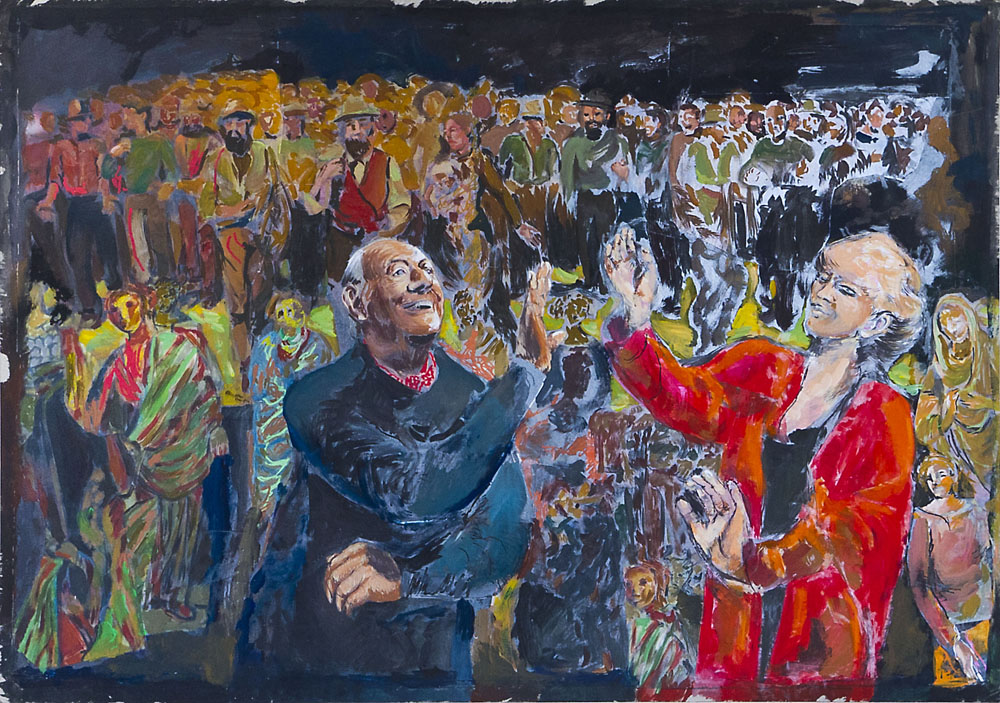
Giuliana de Antonellis – www.gdapress.it
Infoline 02 54913 – www.mostradariofo.it – www.comune.milano.it
fonte: 1fmediaproject.net
